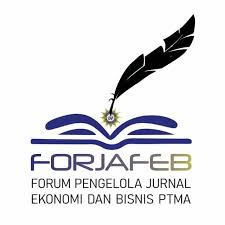Detecting Fraudulent Financial Reporting The Construction Sector In Indonesia: Fraud Triangle
DOI:
https://doi.org/10.32534/jpk.v11i2.5894Kata Kunci:
Teori Fraud Triangle, Konstruksi, KecuranganAbstrak
Kategori kecurangan yang memiliki jumlah kerugian terbesar adalah kecurangan laporan keuangan. Selain merugikan perusahaan secara finansial, laporan keuangan yang curang juga dapat mengancam keberlangsungan perusahaan. Tujuan dari penelitian ini adalah untuk menguji pengaruh target keuangan, stabilitas keuangan, tekanan eksternal, sifat industri dan rasionalisasi terhadap kecurangan laporan keuangan (F-Score) pada perusahaan sektor konstruksi di Indonesia. Penelitian ini bersifat kuantitatif, dengan jenis data sekunder. Jumlah sampel yang digunakan 83 dari total perusahaan sektor konstruksi. Metode analisis yang digunakan adalah regresi logistik. Hasil penelitian menunjukkan bahwa stabilitas keuangan berpengaruh positif, sedangkan target keuangan, tekanan eksternal, sifat industri dan rasionalisasi berpengaruh negatif dan tidak signifikan terhadap kecurangan pelaporan keuangan.
Unduhan
Referensi
ACFE Global. (2020). Report to the Nations on Occupational Fraud and Abuse: 2020 Global Fraud Study. Association of Certified Fraud Examiners, Inc., 1–88. Retrieved from https://www.acfe.com/report-to-the-nations/2020/
Achmad, T., Ghozali, I., Helmina, M. R. A., Hapsari, D. I., & Pamungkas, I. D. (2023). Detecting Fraudulent Financial Reporting Using the Fraud Hexagon Model: Evidence from the Banking Sector in Indonesia. Economies, 11(1), 1–17. https://doi.org/10.3390/economies11010005
Achmad, T., Ghozali, I., & Pamungkas, I. D. (2022). Hexagon Fraud: Detection of Fraudulent Financial Reporting in State-Owned Enterprises Indonesia. Economies, 10(1), 1–16. https://doi.org/10.3390/economies10010013
Achmad, T., Hapsari, D. I., & Pamungkas, I. D. (2022). Analysis of Fraud Pentagon Theory to Detecting Fraudulent Financial Reporting using F-Score Model in State-Owned Companies Indonesia. WSEAS Transactions on Business and Economics, 19, 124–133. https://doi.org/10.37394/23207.2022.19.13
Agusputri, H., & Sofie, S. (2019). Faktor - Faktor Yang Berpengaruh Terhadap Fraudulent Financial Reporting Dengan Menggunakan Analisis Fraud Pentagon. Jurnal Informasi, Perpajakan, Akuntansi, Dan Keuangan Publik, 14(2), 105–124. https://doi.org/10.25105/jipak.v14i2.5049
Alfarago, D., & Mabrur, A. (2022). Do Fraud Hexagon Components Promote Fraud in Indonesia? Etikonomi, 21(2), 399–410. https://doi.org/10.15408/etk.v21i2.24653
Association of Certified Fraud Examiners (ACFE). (2018). Report To the Nations 2018 Global Study on Occupational Fraud and Abuse. 1–80.
Association of Certified Fraud Examiners (ACFE). (2022). Occupational Fraud 2022: A Report to the nations. Association of Certified Fraud Examiners, 1–96.
Association of Certified Fraud Examiners (ACFE). (2024). The Nations Occupational Fraud 2024 :A Report To The Nations. Association of Certified Fraud Examiners, 1–106.
Aulia Haqq, A. P. N., & Budiwitjaksono, G. S. (2020). Analisa teori fraud pentagon sebagai pendeteksi kecurangan pada laporan keuangan. Journal of Economics, Business, & Accountancy Ventura, 22(3), 319–332. https://doi.org/10.14414/jebav.v22i3.1788
Bifadli, I., Hardi, H., & Putra, F. (2023). Deteksi Financial Statement Fraud Dengan Analisis Fraud Hexagon. Jurnal Akuntansi Bisnis, 16(2), 112–129. https://doi.org/10.30813/jab.v16i2.3585
Cheliatsidou, A., Sariannidis, N., Garefalakis, A., Azibi, J., & Kagias, P. (2023). The international fraud triangle. Journal of Money Laundering Control, 26(1), 106–132. https://doi.org/10.1108/JMLC-09-2021-0103
Cressey, D. R. (1953). Other People’s Money: A Study in the Social Psychology of Embezzlement. New York: The Free Press.
Dechow, P. M., Ge, W., Larson, C. R., & Sloan, R. G. (2011). Predicting Material Accounting Misstatements. Contemporary Accounting Research, 28(1), 17–82. https://doi.org/10.1111/j.1911-3846.2010.01041.x
Demetriades, P., & Owusu-Agyei, S. (2022). Fraudulent financial reporting: an application of fraud diamond to Toshiba’s accounting scandal. Journal of Financial Crime, 29(2), 729–763. https://doi.org/10.1108/JFC-05-2021-0108
Ghaisani, H. M., Triyono., & Bawono, A. D. B. (2022). Analysis of Financial Statement Fraud: The Vousinas Fraud Hexagon Model Approach and the Audit Committe as Moderating Variable. The International Journal Of Business Management and Technology, 6(6), 115–125. Retrieved from https://www.theijbmt.com/archive/0948/531684957.pdf
Imtikhani, L., & Sukirman, S. (2021). Determinan Fraudulent Financial Statement Melalui Perspektif Fraud Hexagon Theory Pada Perusahaan Pertambangan. Jurnal Akuntansi Bisnis, 19(1), 96–113. https://doi.org/10.24167/jab.v19i1.3654
Kalovya, O. Z. (2023). Determinants of occupational fraud losses: offenders, victims and insights from fraud theory. Journal of Financial Crime, 30(2), 361–376. https://doi.org/10.1108/JFC-10-2019-0136
Kassem, R., & Omoteso, K. (2023). Effective methods for detecting fraudulent financial reporting: practical insights from Big 4 auditors. Journal of Accounting Literature, 1–24. https://doi.org/10.1108/jal-03-2023-0055
Khamainy, A. H., Ali, M., & Setiawan, M. A. (2022). Detecting financial statement fraud through new fraud diamond model: the case of Indonesia. Journal of Financial Crime, 29(3), 925–941. https://doi.org/10.1108/JFC-06-2021-0118
Kusumawati, E., Yuliantoro, I. P., & Putri, E. (2021). Pentagon Fraud Analysis in Detecting Fraudulent Financial Reporting Using F-Score Model. JURNAL Riset Akuntansi Dan Keuangan Indonesia, 6(1), 74–89. https://doi.org/10.31002/rak.v5i2.3658
Li, J., Li, N., Xia, T., & Guo, J. (2023). Textual analysis and detection of financial fraud: Evidence from Chinese manufacturing firms. Economic Modelling, 126(106428), 1–11. https://doi.org/10.1016/j.econmod.2023.106428
Mandal, A., & Amilan, S. (2023). Preventing financial statement fraud in the corporate sector: insights from auditors. Journal of Financial Reporting and Accounting, 1–25. https://doi.org/10.1108/JFRA-02-2023-0101
Medlar, I., & Umar, H. (2023). Fraud diamond analysis of financial statement fraud. Journal of Management, 13(3), 2132–2143. https://doi.org/10.35335/enrichment.v13i3.1572
Naldo, R. R., & Widuri, R. (2023). Fraudulent Financial Reporting and Fraud Hexagon: Evidence from Infrastructure Companies in ASEAN. Economic Affairs (New Delhi), 68(3), 1455–1468. https://doi.org/10.46852/0424-2513.3.2023.14
Nurhakim, A. L., & Harto, P. (2023). Kecurangan, BUMN Fraud Pentagon: Deteksi Kecurangan Laporan Keuangan Pada Badan Usaha Milik Negara. E-Jurnal Akuntansi, 33(2), 311–330. https://doi.org/10.24843/eja.2023.v33.i02.p03
Putri, N. S., & Januarti, I. (2023). Perspektif Fraud Diamond dalam Mendeteksi Kemungkinan Kecurangan Laporan Keuangan. E-Jurnal Akuntansi, 33(3), 619–633. https://doi.org/10.24843/eja.2023.v33.i03.p03
Rahman, M. J., & Jie, X. (2024). Fraud detection using fraud triangle theory: evidence from China. Journal of Financial Crime, 31(1), 101–118. https://doi.org/10.1108/JFC-09-2022-0219
Sari, M. P., Sihombing, R. M., Utaminingsih, N. S., Jannah, R., & Raharja, S. (2024). Analysis of Hexagon on Fraudulent Financial Reporting with The Audit Committee and Independent Commissioners as Moderating Variables. Quality - Access to Success, 25(198), 10–19. https://doi.org/10.47750/QAS/25.198.02
Setyono, D., Hariyanto, E., Wahyuni, S., & Pratama, B. C. (2023). Penggunaan Fraud Hexagon dalam Mendeteksi Kecurangan Laporan Keuangan. Owner, 7(2), 1036–1048. https://doi.org/10.33395/owner.v7i2.1325
Sholikatun, R., & Makaryanawati, M. (2023). Determinan Kecurangan Laporan Keuangan (Perspektif Fraud Hexagon Theory). EKUITAS (Jurnal Ekonomi Dan Keuangan), 7(3), 328–350. https://doi.org/10.24034/j25485024.y2023.v7.i3.5484
Situngkir, N. C., & Triyanto, D. N. (2020). Detecting Fraudulent Financial Reporting Using Fraud Score Model and Fraud Pentagon Theory : Empirical Study of Companies Listed in the LQ 45 Index. The Indonesian Journal of Accounting Research, 23(3), 373–410. https://doi.org/10.33312/ijar.486
Sudrajat, S., Suryadnyana, N. A., & Supriadi, T. (2023). Fraud Hexagon: Detection of Fraud of Financial Report in State-owned Enterprises in Indonesia. Jurnal Tata Kelola Dan Akuntabilitas Keuangan Negara, 9(1), 87–102. https://doi.org/10.28986/jtaken.v9i1.1358
Sukmadilaga, C., Winarningsih, S., Handayani, T., Herianti, E., & Ghani, E. K. (2022). Fraudulent Financial Reporting in Ministerial and Governmental Institutions in Indonesia: An Analysis Using Hexagon Theory. Economies, 10(86), 1–14. https://doi.org/10.3390/economies10040086
Tarjo, T., Anggono, A., & Sakti, E. (2021). Detecting Indications of Financial Statement Fraud: a Hexagon Fraud Theory Approach. AKRUAL: Jurnal Akuntansi, 13(1), 119–131. https://doi.org/10.26740/jaj.v13n1.p119-131
Tuanakotta, T. M. (2010). Akuntansi Forensik & Audit Investigatif. Penerbit Salemba Empat, 944 Hlm. Retrieved from https://penerbitsalemba.com/
Wijaya, T., & Witjaksono, A. (2023). Unmasking Financial Deception: Unraveling the Fraud Hexagon’S Influence on Detecting Financial Statement Fraud in Indonesian Public Companies. Journal of Applied Finance and Accounting, 10(1), 47–56. https://doi.org/10.21512/jafa.v10i1.9927
Wilantari, N. M., & Ariyanto, D. (2023). Determinan Fraud Hexagon Theory dan Indikasi Financial Statement Fraud. E-Jurnal Akuntansi, 33(1), 87–103. https://doi.org/10.24843/eja.2023.v33.i01.p07
Yadiati, W., Rezwiandhari, A., & Ramdany. (2023). Detecting Fraudulent Financial Reporting In State-Owned Company: Hexagon Theory Approach. JAK (Jurnal Akuntansi) Kajian Ilmiah Akuntansi, 10(1), 128–147. https://doi.org/10.30656/jak.v10i1.5676
Yanti, H. B., Mayangsari, S., Wiyono, S., Noor, I. N., Siregar, M., & Desiani, I. (2023). Prediction of Financial Reporting Fraud With Crowe’S Fraud Pentagon Model. Media Riset Akuntansi, Auditing & Informasi, 23(1), 183–202. https://doi.org/10.25105/mraai.v23i1.17293
Yarana, C. (2023). Factors Influencing Financial Statement Fraud: An Analysis of the Fraud Diamond Theory from Evidence of Thai Listed Companies. WSEAS Transactions on Business and Economics, 20, 1659–1672. https://doi.org/10.37394/23207.2023.20.147
Yusrianti, H., Ghozali, I., Yuyetta, E., Aryanto, & Meirawati, E. (2020). Financial statement fraud risk factors of fraud triangle: Evidence from Indonesia. International Journal of Financial Research, 11(4), 36–51. https://doi.org/10.5430/ijfr.v11n4p36
Zenzerovi?, R., & Šajrih, J. (2023). Financial statements fraud identifiers. Economic Research-Ekonomska Istrazivanja, 36(3), 1–13. https://doi.org/10.1080/1331677X.2023.2218916
Unduhan
Diterbitkan
Terbitan
Bagian
Lisensi
Hak Cipta (c) 2024 Eko Pujiyono Yono, Indira Januarti Indira

Artikel ini berlisensi Creative Commons Attribution 4.0 International License.




















